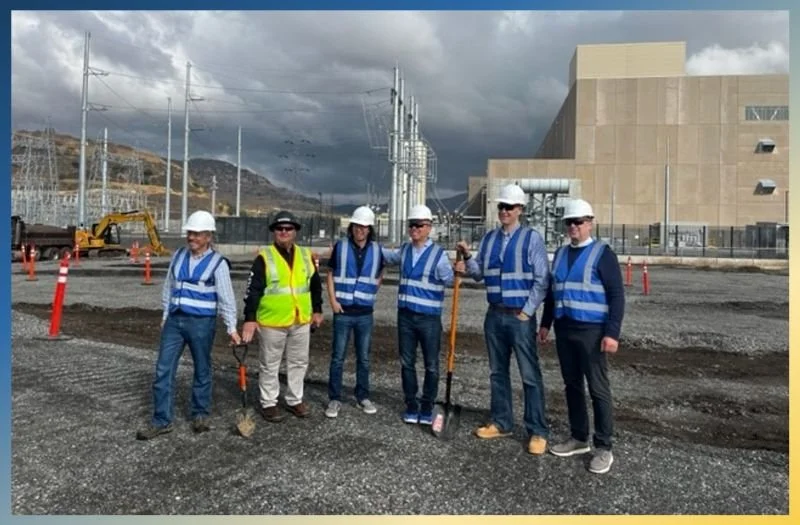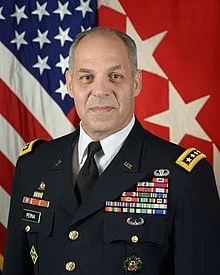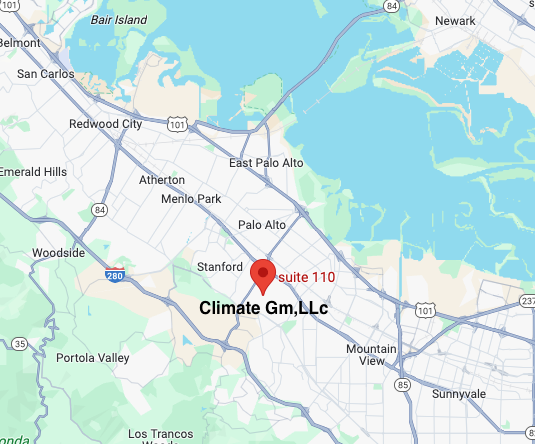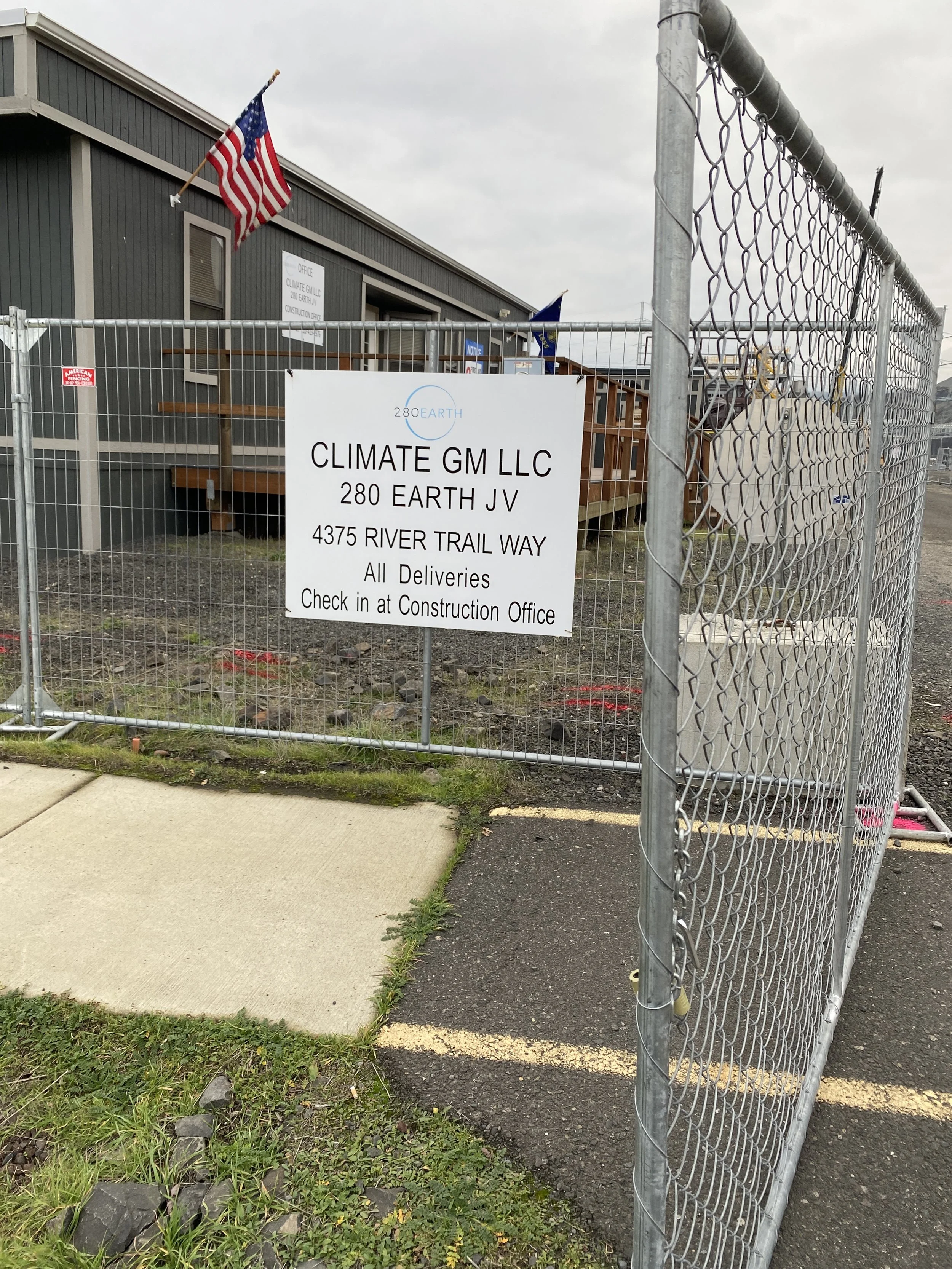Billionaire investors banking on TD in race to crack CO2 code
Work at the Earth 280 demonstration facility was in high gear today, Dec. 15 in the Port of The Dalles as Google and several other partners hope to get the Direct Air Capture of carbon dioxide going in early 2024 in a push to stop global warming.
By Tom Peterson
Darren Bonnstetter of Mountain View, Calif., is listed as the CEO of Climate GM, LLC in Oregon which is doing business in the Port of The Dalles as Earth 280.
A recent land sale in The Dalles for $1.4 million might have some positive world outcomes.
The 2.79 acres purchased at 4375 RiverTrail Way near Taylor Lake and the Google 3 data plant were alive with some 15 construction workers who toiled under drab grey skies today, Dec. 15.
They were erecting a demonstration facility to mine the air of its carbon dioxide or CO2, in a step to prevent the earth from getting too hot for humans.
The project has impacts that are twofold as it brings another economic injection for local service and trade industries. And then there is this - the project might just contribute to saving a good part of the human race.
From the Oregon Department of Treasury Instagram: - “During a visit to the Colombia River Gorge in August, Treasurer Tobias Read joined the groundbreaking ceremony for 280 Earth's direct air capture facility (in the Port of The Dalles). As part of a national effort to reduce CO2 emissions in the atmosphere, the facility will help in the fight against climate change,” the cutline reads.
Google X, a research and development facility founded by Google in 2010, is calling the project Earth 280 JV. It will capture 500 tons of CO2 per year, which is small potatoes in the fight against global warming. The U.S. alone emitted between 5 billion and 6 billion tons in 2022, according to a range of experts.
But here’s the kicker.
John Pimentel is the Registered Agent for Climate GM, LLC, aka Earth 280, according to the Oregon Business Registry. He is also listed as the Senior Vice President of Business Development.
“This machine is highly instrumented to measure inputs, sorbent (or CO2 molecule collection) performance, yields, and system processes to clarify scale-up designs and long-term capital/operating costs,” Google X said in a press release.
Meaning, this is the prototype to improve and scale up to do much larger CO2 capture in future plants
“280 Earth's Generation 1 production module captures over 5,000 tons per year of CO2 and is designed to deploy in series. In the first three months of 2025, the first of four Generation 1 units will be installed at the commercial demonstration facility in The Dalles. By late 2025 or early 2026 we expect the site's full production capability will be more than 20,000 tons per year,” the release states.
Race to Sequester
Google is just one of many players in the carbon capture game as the U.S. is funding research and construction to crack the carbon code. The 2021 Infrastructure Investment and Jobs Act provides $8.2 billion in advance cash for carbon capture and storage programs over the 2022–2026 period, according to the Congressional Budget Office.
The incentive is working.
General Gustave Perna, a retired United States Army four-star general, is listed as an employee at Earth 280, according to a Google Search. Wikipedia states general oversaw the logistics in the United States federal government's distribution of the vaccine to the COVID-19 pandemic.
Hermiston announced a carbon capture project that intends to send C02 underground and attach it to the basalt to offset emissions from natural gas.
The Wallula Basalt Project in Eastern Washington in 2015 demonstrated the viability of a similar technology.
In January of 2023, The Department of Energy announced $131 million for 33 research and development projects to advance the wide-scale deployment of carbon management technologies to reduce CO2 pollution.
That is not lost on Big Players such as Google.
“The company will develop, design, finance, build, own, and operate its own projects using 280 Earth equity, 45Q tax credits, the sale of voluntary carbon credits, and eventually traditional project financing,” according to the Google X press release. The company “is also entertaining arrangements with multiple companies such as oil majors and utilities where 280 Earth may contribute its technology, expertise and capital to co-develop and co-own projects with strategic partners.
This locator map shows the principal place of business for Climate GM, LLC in Palo Alto as identified with the Oregon Secretary of State Business Registry. It lands pretty close to Mountain View, home of Google headquarters. Climate GM, LLC is doing business as Earth 280 in The Dalles.
280 Earth partnered with Chevron on the Western Regional Direct Air Capture Hub, which was recently selected for $3 million of Department of Energy Regional Direct Air Capture Hubs funding.”
About that 280 Tech
“The system pulls large quantities of air through an adsorption chamber where carbon dioxide (CO2) and water (H20) attach to the sorbent (a chemical compound). The sorbent then goes into a chamber called the desorber where the CO2 and water are released. The CO2 is then captured for sequestration or use in beneficial products.
Google X/280 Earth created a long-lasting, durable sorbent with a low temperature activation point. Up to 80% of the system's thermal requirement can be addressed using waste heat from Industrial facilities such as power plants, data centers, or refineries. The system generates water and is capable of supporting adjacent industrial cooling systems,” the press release states.
Welcome to The Dalles
Sergey Brin co-founded Google with Larry Page in 1998 in Menlo Park, Calif.
280 Earth has four major owners from the San Francisco Bay area who invested $15 million each to start the company:
Google, Inc.;
Bayshore Global Management - a $30 billion company owned by Google founder Sergey Brin and his wife Anne Wojcicki;
Yu Capital - Wendy Yu (余晚晚) is a Chinese pioneer fashion and technology investor, entrepreneur and philanthropist. She is the founder and CEO of YU Capital, an investment-funding company that supports high-potential, high-growth fashion, lifestyle and technology enterprises internationally. The company’s most recent acquisitions include ASAP54, the fashion search and discovery app with revolutionary image recognition functionality; and Bottletop, a sustainable eco-luxury fashion brand. In 2015, Yu Capital also invested in Didi Chuxing, the largest taxi-hailing firm in China, its investors include Apple, Alibaba and Tencent with a current valuation of over $28 billion.
and, Builders VC - Founded in 2014, Builders VC is a venture capital firm based in San Francisco, California.
The demonstration facility is in the foreground with the crane above it and the Google 3 Data Center is in the background in the Port of The Dalles.
And what about that name, Earth 280?
If you were a carbon cruncher, you’d get it.
Earth 280 refers to 280 parts per million (PPM) of carbon dioxide, a level that is comfortably inhabitable by mankind, according to the National Oceanic and Atmospheric Administration or NOAA . And the company’s goal, one could assume, is to reduce the current global average of 417 PPM, also according to NOAA, into hospitable levels - preferably, before the earth warms 2 degrees Celsius in decades to come, spurring greater fires, bigger floods, landslides, and crop failures.
NOAA Monthly Global Climate Report/September
—-
CCCNews contacted the company’s Trent Gilfoil and Amanda Hartman to get comment from the company’s leadership, John Pimentel and Darren Bonnstetter. We will update this story if they choose to respond - Tom Peterson.
Support Local News
Available to all. Funded by readers.









